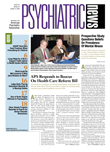The neighborhood environment to which your patient returns after hospitalization can affect continuity of care.
That was the finding from a study of neighborhood environmental factors affecting the likelihood that dually diagnosed patients returning home from a hospitalization would attend their first outpatient follow-up visit and the likelihood of rehospitalization. The study appeared online October 1 in AJP in Advance.
For instance, researchers found that patients returning to a neighborhood with a high vacant-housing rate and a greater distance from the nearest Alcoholics Anonymous (AA) meeting location were more likely to skip their first outpatient follow-up visit. Patients living in a neighborhood with a greater number of Narcotics Anonymous (NA) meetings—possibly suggesting a greater density of drug-addicted individuals in the nearby environment—were more likely to be rehospitalized, while patients living in areas with higher educational attainment were less likely to be rehospitalized.
But lead author Gerald Stahler, Ph.D., of the Department of Geography and Urban Studies at Temple University in Philadelphia, said that more important than the specific variables that were found is the recognition of the neighborhood environment as a factor in continuity of care.
“We need to expand our current assessment of the patient to include, or at least consider, the role of the neighborhood environment in determining follow-up care postdischarge,” Stahler told Psychiatric News.“ Currently, hospital discharge planning treatment staff rarely take into account the overall quality of a patient's neighborhood or proximity to certain environmental features that might trigger relapse and rehospitalization. Patients are often influenced by the environment in which they live, and therefore we believe that a more explicit focus on an individual's neighborhood and community context represents an important but understudied area in psychiatry. We believe that such a focus can potentially enhance long-term care and treatment planning for psychiatric patients.”
The study coauthors were David Baron, D.O., of the Department of Psychiatry and Behavioral Science at Temple; Jeremy Mennis, Ph.D., an associate professor of geography and urban studies at Temple; and Rachel Cotlar, a research assistant in the Department of Geography and Urban Studies.
The study was a retrospective analysis that utilized data extracted from the medical charts of patients who had co-occurring substance use and mental disorders and were treated in an acute inpatient unit at Temple University Hospital–Episcopal Campus. Researchers obtained administrative data on whether they arrived at their first outpatient appointment within a month of discharge and whether they were rehospitalized within a year.
Also, Stahler said he and Mennis—who is an international expert in geographic information science—have been developing a geographic database relating to Philadelphia from a variety of publicly available data sources. “We not only have census data, but also data that we believe may relate to substance abuse, such as the locations of various kinds of alcohol outlets, check-cashing stores, pawn shops, AA and NA meeting locations, substance abuse treatment centers, and drug-arrest data,” he said.
“Our predictor variables included individual-level data from the medical charts, such as demographic information, psychiatric assessment information, drug-use data, housing status, criminal justice history, victimization data, and disability status,” Stahler said. “The selection of these variables was based on prior research relating to treatment outcomes for the study population and information routinely available from medical records.”
The study sample included 380 patients who, upon hospital admission, had one or more mental health disorders and a positive urine drug screen for prototypical illicit drugs. In general, the sample represented a primarily poor, inner-city, minority population, with the majority being active cocaine users (61 percent).
Slightly less than one-half of the patients in the sample (43 percent) kept their initial outpatient appointment within 30 days of discharge from the acute inpatient unit, and about one-half (51 percent) were rehospitalized within one year.
“One of the biggest challenges in treating dually diagnosed patients is maintaining aftercare treatment once they leave an acute inpatient unit,” Stahler said. “We know that substance abuse is a chronic relapsing disease, and those with cooccurring mental disorders are at particular risk for relapse and rehospitalization. So having patients continue in treatment after leaving the hospital is particularly important. Unfortunately, I don't believe that the number of patients in our study who did not keep their outpatient appointments or who were rehospitalized within a year were atypical for this kind of patient population. I think what this speaks to is the necessity for finding ways to increase our ability to have patients continue in treatment after hospitalization.”
In addition to the vacant housing rate in a neighborhood and paucity of AA meeting locations, other nonenvironmental factors predicting likelihood of missing an outpatient follow-up visit were having the chief complaint of bizarre behavior—that is, grossly inappropriate behavior—and having a urine drug screen positive for heroin.
The likelihood of being rehospitalized within one year was greater for Hispanic patients, patients who had at least one prior hospital admission, and patients who lived in close proximity to an NA meeting location.
Stahler said that this kind of research—utilizing geographic information systems and spatial modeling to look at the influence of the neighborhood environment on continuity of care and rehospitalization for dually diagnosed patients—is relatively new.
“If we better understand the elements of the neighborhood environment that are likely to affect relapse, rehospitalization, and continuity of care for patients, we can enhance our ability to provide better aftercare planning, which will hopefully lead to more successful long-term patient outcomes,” he said.
